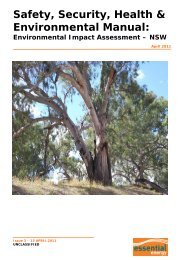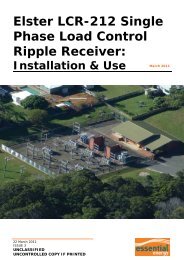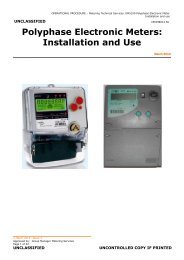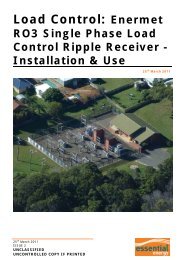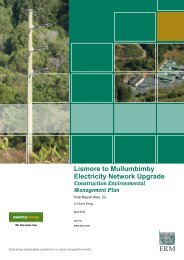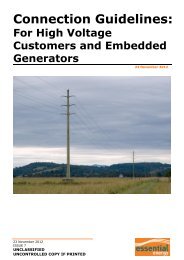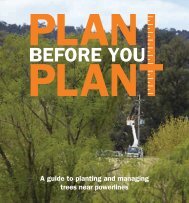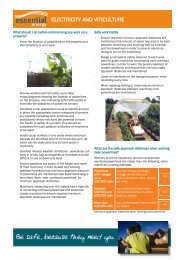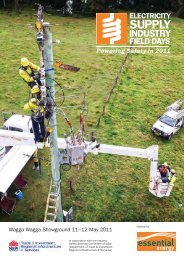Full Version - Essential Energy
Full Version - Essential Energy
Full Version - Essential Energy
Create successful ePaper yourself
Turn your PDF publications into a flip-book with our unique Google optimized e-Paper software.
10<br />
ACE campaign<br />
An important part of our new public safety campaign<br />
is an animated power cord called ACE and his<br />
guardian, the safety cross. Using the latest animation<br />
technology, we created lively characters to appeal to<br />
the younger generation and communicate serious<br />
safety issues.<br />
The three new advertisements focus on storms,<br />
substation and agribusiness safety. ACE has also<br />
been incorporated into our internal safety program.<br />
ACE – the star of a new public safety campaign<br />
National safety field days<br />
Almost 1,000 energy industry representatives attended<br />
the 2005 energy industry safety field days hosted<br />
by Country <strong>Energy</strong> at Tamworth in June – from field<br />
employees and health and safety professionals to<br />
industry suppliers, tradespeople and local government<br />
representatives.<br />
While maintaining the traditional focus on competitions<br />
and exhibitions, <strong>Energy</strong> Safety Solutions 2005 put<br />
the spotlight back on learning and skills sharing.<br />
Highlights included seminars on lightning awareness,<br />
understanding equipotential bonding, shock incident<br />
investigation, pole top and confined space rescue and<br />
new testing technology.<br />
The annual field days are a major industry event,<br />
hosted by members of the industry in association<br />
with the Industry Safety Steering Committee of New<br />
South Wales (Department of <strong>Energy</strong>, Utilities and<br />
Sustainability).<br />
Future goals – host highly successful, high-profile<br />
safety field days in 2006.<br />
The year ahead<br />
Nine critical safety processes have been identified for<br />
2005-2006, and each will be thoroughly investigated<br />
and revised to incorporate feedback from employees<br />
and best practice safety solutions worldwide.<br />
The processes, which relate to the majority of incidents<br />
and injuries include –<br />
• Emergency preparedness<br />
• Manual handling<br />
• Working at heights<br />
• Working in a noisy environment<br />
• Working in confined spaces<br />
• Working with and using electricity<br />
• Working with and using gas<br />
• Working with dangerous goods and hazardous<br />
substances<br />
• Working with plant<br />
These critical safety processes will be supported by<br />
initiatives such as Powerful Health, Safety Sense and<br />
workers compensation self insurance.<br />
Future goals – Roll out all initiatives in Far West region<br />
following merger with Australian Inland. Lost Time<br />
Injuries (LTIs) reduced to 35, Medically Treated Injuries<br />
(MTIs) reduced to 130, increased awareness and use<br />
of WIN system to help reduce incidents.<br />
Safety Sense<br />
A new incentive program – known as Safety Sense<br />
– will be rolled out in July 2005 to give employees that<br />
have demonstrated a safe and responsible approach to<br />
their day-to-day work the chance to ‘scratch and win’<br />
a range of instant prizes. Anyone displaying desirable<br />
safety behaviours receives a safety sense scratchie<br />
and employees can also nominate work mates who<br />
they believe have ‘Safety Sense’.<br />
This includes any act, attitude, behaviour, work<br />
practice or suggestion that has a positive effect on our<br />
safety performance or improving safety culture. It can<br />
also include exceptional safety performance such as<br />
resolving an unsafe condition, superior housekeeping<br />
or making an outstanding safety suggestion.<br />
Aimed at reducing lost time and medically treated<br />
injuries and promoting a strong safety culture,<br />
the program encourages employees to actively<br />
demonstrate their commitment to safety in daily<br />
work activities. It hinges on the idea that behaviour<br />
that is rewarded is more likely to be repeated.<br />
COUNTRY ENERGY ANNUAL REPORT 2004–2005




